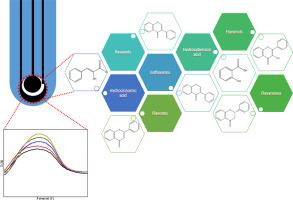Electrochemical sensors for the determination of polyphenols as antioxidants from natural sources: A comprehensive review of sensor development and characterization
IF 3.7
Q1 CHEMISTRY, ANALYTICAL
引用次数: 0
Abstract
The rapid, sensitive, and selective quantification of polyphenols has become increasingly important in areas such as food quality control, nutraceutical development, and biomedical diagnostics, due to their exhibiting significant antioxidant properties through their redox-active hydroxyl groups, contributing to a variety of pharmacological effects, including anti-inflammatory, cardioprotective, and chemopreventive activities. This review critically examines recent developments in electrochemical sensor platforms tailored for polyphenol detection in complex biological and environmental samples. Emphasis is placed on nanostructured electrode modifications employing carbon-based nanomaterials (e.g., graphene, carbon nanotubes), metal nanoparticles (Au, Ag, Pt), and metal oxide nanostructures (e.g., TiO₂, ZnO) that facilitate enhanced electron transfer rates, augmented electroactive surface area, and improved sensor stability and reproducibility. The review further explores diverse electrochemical transduction techniques, including cyclic voltammetry, square wave voltammetry, differential pulse voltammetry, and electrochemical impedance spectroscopy, with comparisons of enzymatic and non-enzymatic sensing approaches. Detailed mechanistic insights into polyphenol electrooxidation pathways, adsorption phenomena, and sensor–analyte interfacial interactions are discussed. Complementary spectroscopic and microscopic characterization methods are highlighted for their roles in elucidating structural, electronic, and surface properties critical to sensor functionality and analytical performance.

电化学传感器用于测定天然来源的抗氧化剂多酚:传感器发展和表征的综合综述
多酚通过其氧化还原活性羟基表现出显著的抗氧化特性,有助于多种药理作用,包括抗炎、心脏保护和化学预防活性,因此多酚的快速、敏感和选择性定量在食品质量控制、营养制剂开发和生物医学诊断等领域变得越来越重要。本文综述了电化学传感器平台在复杂生物和环境样品中多酚检测方面的最新进展。重点放在纳米结构电极修饰,采用碳基纳米材料(如石墨烯,碳纳米管),金属纳米颗粒(Au, Ag, Pt)和金属氧化物纳米结构(如TiO₂,ZnO),促进提高电子转移速率,增加电活性表面积,提高传感器的稳定性和可重复性。本文进一步探讨了多种电化学转导技术,包括循环伏安法、方波伏安法、差分脉冲伏安法和电化学阻抗谱,并对酶和非酶传感方法进行了比较。详细的机制见解多酚电氧化途径,吸附现象和传感器-分析物界面的相互作用进行了讨论。互补的光谱和微观表征方法在阐明结构、电子和表面特性方面的作用,对传感器功能和分析性能至关重要。
本文章由计算机程序翻译,如有差异,请以英文原文为准。
求助全文
约1分钟内获得全文
求助全文

 求助内容:
求助内容: 应助结果提醒方式:
应助结果提醒方式:


